Tags
AFRICA, baobabs, Indian Ocean, islands, lemurs, Madagascar, sailboats, sailing
“Why Madagascar?” I ask Lisa when she suggests I visit during her four-month anchorage off the coast of this Indian Ocean island. I’m thinking I might wait until one of her next few stops, in South Africa or maybe Namibia, to parachute into her floating world for a brief stay. But baobabs, the thick, upside-down African trees I’ve seen once before, are one quirky draw, and I am eager to interact in the wild with lemurs, the tiny primates that live only in Madagascar. Beyond the unique flora and fauna, however, I know little about this poor island nation and am unconvinced I should spend thousands of dollars and many days of my time to get to it for a week or so this summer.
I let the idea languish until I try to explain to my sister one day why I can’t get the idea out of my head. By then, I’ve found flights both ways using miles, devoured all the links Lisa has sent on the country, and read her enthusiastic reviews of Nosy Be, the biggest island off the northwest coast of Madagascar. I hang up feeling I have convinced my sister I should go … and then wonder why on earth I haven’t booked it yet! I lock it down that afternoon.
A few months later, I land in Hell-ville, the only real city on Nosy Be, meet Lisa and The Captain for the first time (a story in itself), and am whisked to their sailboat for the next week. I tried hard to include parts of the main island in my visit, but even though I am a pretty brave solo female traveler, everything I read says it is a very bad idea to try getting around there on my own. Once on the boat, listening to The Captain relate his own aborted attempt to travel there with a friend, I am glad I elected to simply stay on the water and see the smaller islands in the Mozambique Channel.
I throw myself wholeheartedly into the life aquatic. I pop up jetlag-free after night one in my rocking boat-cradle, stuff myself into a wetsuit, strap on a mask and a snorkel, and topple over the side of the dinghy for my first Indian Ocean swim, this time with sea turtles off the coast of Nosy Sakatia.
My underwater camera does not do justice to these majestic creatures, who munch a while on the bottom plant growth, then breast-stroke to the surface in graceful slow-motion, all within inches of us humans.
I’ve been here less than a day, and I’m already in another world, lulled by the sea, by the creatures and coral below, by a patch of jumping fish flashing in the sun above. I feel extravagantly far from home.
A diurnal rhythm emerges in the following days – up with the sun and usually out with the local fleet in the morning and, later, drinks on deck as the same orb sets, igniting the sea and coastline. The local boats are things of great beauty and ingenuity. Often simple, wooden canoe-like vessels with home-made sails, the boats and their dexterous sailors skim the ocean in search of fish, as a means of transportation among islands, and even as small floating purveyors of goods like fruits and vegetables.
Day’s end comes earlier here, not too far south of the equator, and by 6 pm, we have front row seats for the sunset show in various anchorages. Whether it is illuminating the water, a nearby landmass, another boat, or just the shiny metal parts of ours, the sun is our nightly source of art and entertainment, a tangerine-pink glow that deepens in front of our eyes before our watery world plunges into darkness.
In between wake-up and a climb back into my cozy berth below-deck, there is a new kind of magic every day: the bestowing of gifts upon the mpanjaka (island queen) on still-primitive Nosy Mamoko. A hike almost the whole way around that rocky island with friendly local Thom, the epitome of patience as we scramble for hours over slippery rocks and I somehow snap the sole off my shoe halfway through.
More snorkeling, this time off Tanikely, where we spy vast schools of flat, round fish and a huge red snapper. On the more developed Komba, I play a one-on-one soccer match with a six-year-old while Lisa is busy taking and printing photos of the islanders, and there I also meet an enigmatic Italian man who has singlehandedly transformed life on one end of the island over the last twenty-five years. We hike along the beach and up into the hills, and miraculously find a crusty baguette (we are both bread fiends) at the end of the day on the dusty main street.
I seek out the lemurs, the bright-eyed prosimian primates that live only on Madagascar. I’ve been lucky to see lemurs in a research facility before, so I know the little imps will be friendly. I am not, however, wholly expecting to become their jungle gym. I should know that the little bits of banana I carry to attract them will mean lemurs on my arms, my shoulders, and my legs, with the capper being a lemur fight on my head, my hair snarled beyond redemption.
The country is achingly poor, among the top ten neediest nations in the world, and the markets in Hell-ville are busy but ramshackle, a shocking amount of litter covers the main city shores, and local officials have no qualms about asking visitors for “little gifts” at the docks or the airport.
At the same time, the town feels comfortable and open to outsiders, and the true treasures both here and on the smaller islands are the people. We are met with shy smiles and sincere attempts to communicate everywhere we go. They are a beautiful and reserved bunch in general, sometimes even wary, but we feel absolutely welcome everywhere.
It’s a surprisingly rich cultural experience for such a short time in the country; we even luck into a brass band parade on Nosy Komba one morning and just miss getting to attend a festival on Mamoko the day before.
By the time I leave, baobabs are but a backdrop to this beguiling series of islands that broke off from the African continent millions of years ago. Much of an African nature remains, but Hell-ville and some of the more established islets also feel distinctively Polynesian, vaguely Arab, certainly French, with a healthy dash of other Southeast Asian flavors thrown in. It’s a mysterious and heady mix, and our small but unhurried explorations make for one of the most absorbing trips I’ve ever taken.
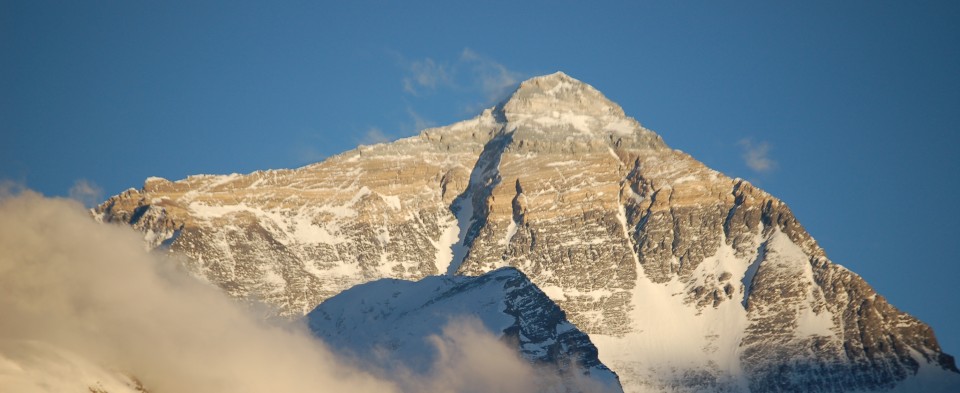
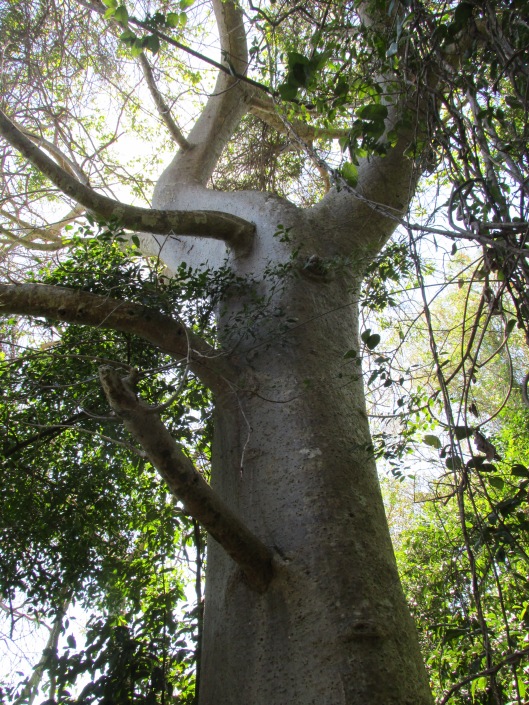
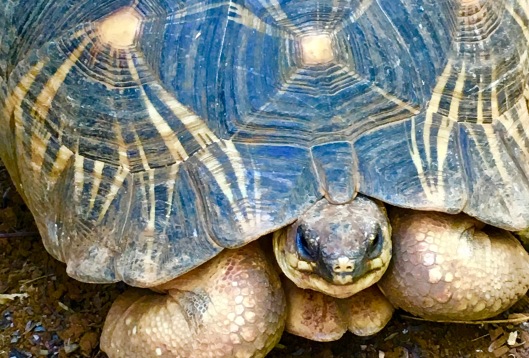


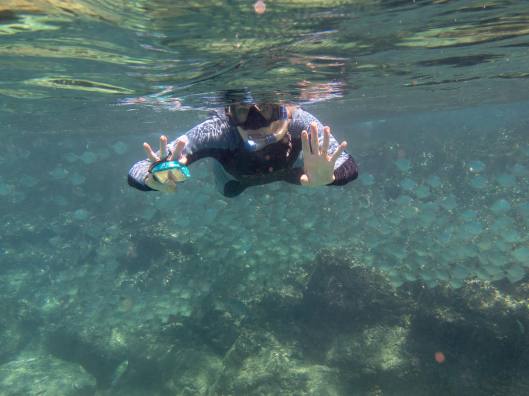

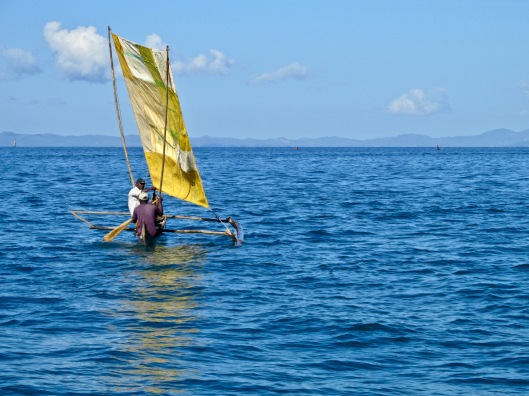



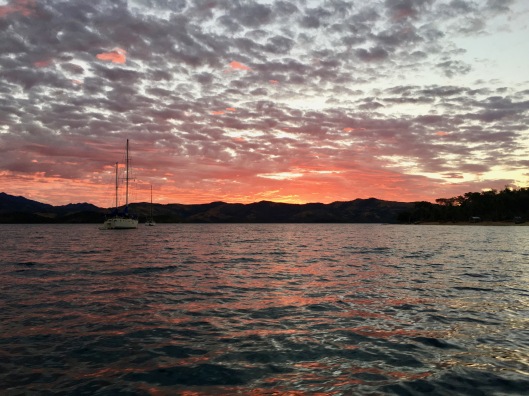
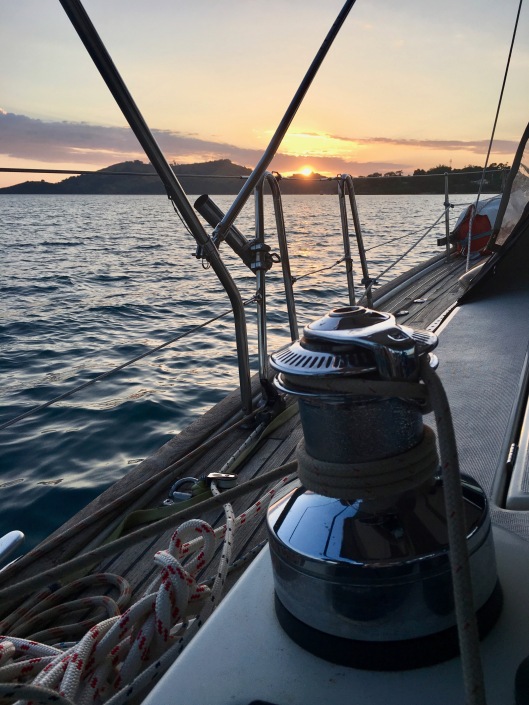






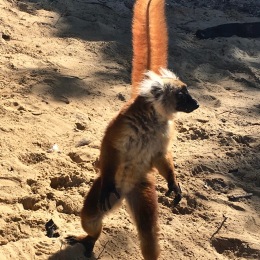
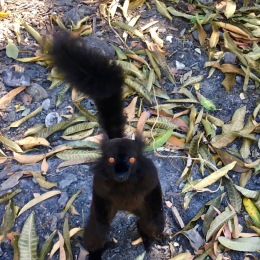




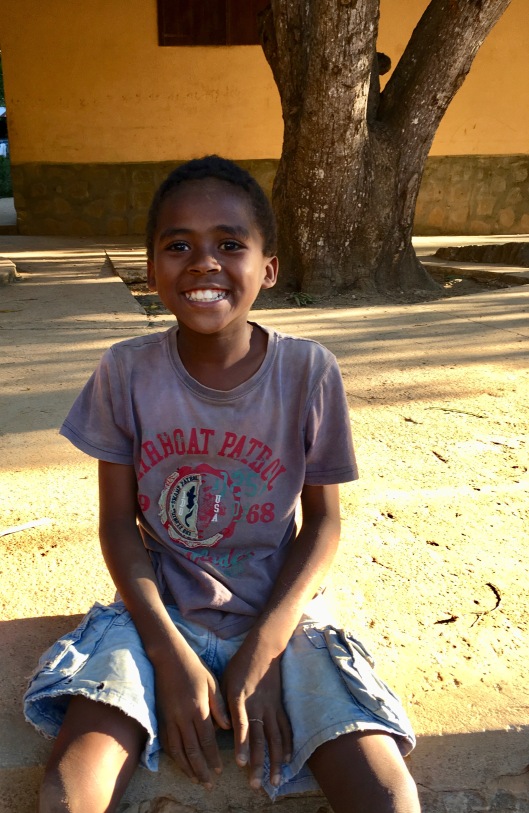



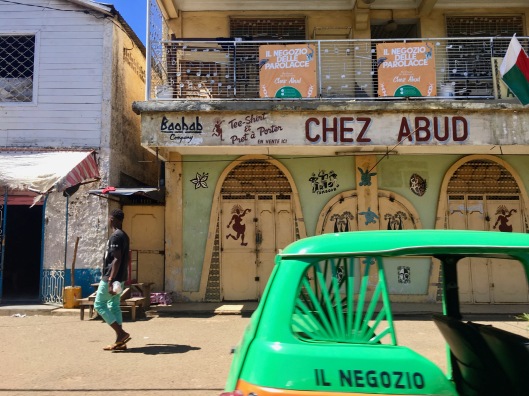
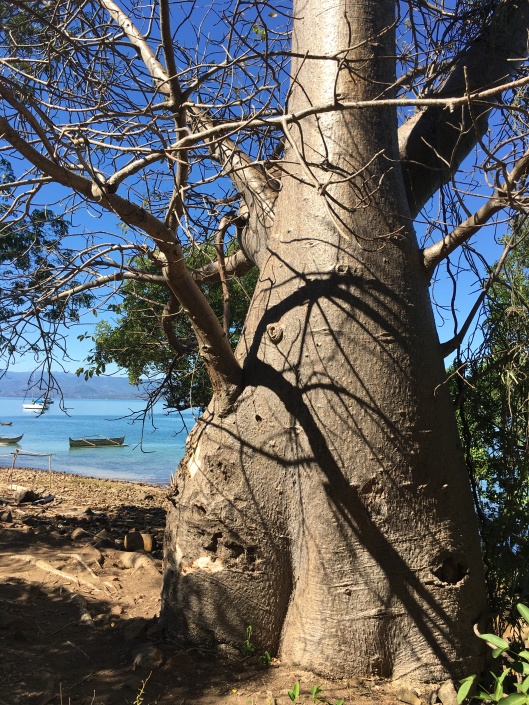
Whatever form it takes, staying on the water (or land) and seeing the smaller islands (or villages) always is a good idea. I’m charmed by several details here: the baobab, the beautiful cloths on the beach, the extravagant, complicated hair braiding. I laughed at the “little gift” reference. In Liberia, the question is, “Do you have cold water for me?”
With roller furling, good lines, and what look to be Lewmar winches, your friends are pretty well outfitted. What kind of boat do they have? Length? Are there boat pictures coming? You may not have been so interested as I am!
LikeLiked by 1 person
It was (for me) a unique way to both stay and travel, and I loved every minute of it. The cutwork tablecloths all strung up on the beach were like an art installation (Christo, perhaps?!); I must have taken dozens of photos, and the all-white scenes were my favorites.
The boat was beautiful. It is a Beneteau, 14.9 meters long, and I have a photo of it in my previous post (A Leap of Faith- 3rd photo overall; 1st boat)); I was so excited to be approaching in the dinghy for the first time after my arrival! I was actually fascinated by their boat. I grew up with boats (mostly motor, not sail), and I love all kinds of watercraft. I’m sure you would have been charmed by it (and them!).
LikeLiked by 1 person
Such an interesting insight into a little known country. What a great experience you had!! Really enjoyed reading and looking at your photos.
LikeLiked by 1 person
Thank you, Debbie! It really was a unique trip – hard to even put it all into words!
LikeLiked by 1 person
This truly was an adventure of a lifetime! I’m so happy that you took advantage of Lisa’s generous offer… and are now sharing your trip with us. Those lemurs are amazing… I guess there was little concern that they would scratch or bite? My favorite photo out of all of your wonderful photos was the one of the two little girls on the shore… absolutely adorable.
LikeLiked by 1 person
You are right – about the adventure of a lifetime, that we knew the lemurs were not likely to bite us, and that the two little girls were completely adorable! The lemurs were almost gentle, taking the pieces of banana delicately out of our hands. The only reason they scratched around in my hair at one point was that I had attracted too many at once and they were scrabbling with each other for the banana. When I tipped my head down, they jumped right off. I must have taken a dozen photos just of those two girls in the matching dresses on the beach. 🙂
LikeLiked by 1 person
This sounds like the most glorious interlude. I can feel the joy and peace radiating from your words and wonderful pictures. Now I want to add it to my list!
Alison
LikeLiked by 1 person
An interlude is exactly what this experience was – a drop into a world unlike any I usually know! It was incredibly peaceful; just being on the water always is, but the fact that we had no major agenda each day added to the serenity. We did plan to see a certain number of islands, but none was far, and the sailing itself, especially when under nothing but wind power, was a big part of the fun (at least for me – they had to do all the work! 🙂 )
LikeLiked by 1 person
Another beautiful post on what life is like with Lisa. 🙂 Your visuals (written and photographed) take me with you on those bouncy waves. It’s so different from all the views we’ve been seeing so far. I’ve been hoping for a change in scenery, but I don’t think we have any trip planned outside Asia for the next 2 years. 😦 I’m so glad you followed your heart and I got to go on a virtual trip with you. 🙂
LikeLiked by 1 person
I know what you mean about a change in scenery (this was certainly one for me), but from my vantage point, traveling in Asia alone sounds incredibly exciting! I loved following you to Indonesia, for example, and Asia is always on the top of my list when I ponder new trips. Of course, it’s your home continent, so you feel it’s more of the same … But speaking of home turf, I’ve been drawn lately to my own part of the world and hope to spend some time in the coming year finishing off the 50 U.S. states and some other, closer destinations. Enjoy your time there while you have it; who knows where we will all be next?
LikeLiked by 1 person
Thanks for the beautiful trip! Smile glued to my face at each line, thanks again for sharing your inspiring adventures 🙂
LikeLiked by 1 person
Glad I could bring you a new part of the world … and a smile to go with it! (Lemurs can do that!)
LikeLiked by 1 person
Why Madagascar? You answered that so wonderfully on this post by showing how much there is to immerse yourself in around the islands. Sounds like being on the boat and water was a good choice and safe…except for the part when there was damage to your shoe. Did you get it replaced or did you just soldier on? It does sound like the lemurs saw you as a great friend, and slightest bit of food gets them excited. Hell-ville may be poor but everyone sure knows how to appreciate what they’ve got.
LikeLiked by 1 person
Just hanging out on the boat and hitting a few islands over the week was a great course for this trip! My shoe sole flapped and flapped for the last part of the hike, making the walk quite difficult, but it did hang on somehow. We cleaned up the shoes, Lisa and Fabio got the sole glued back on after I left, and then they donated the shoes to a favorite local guy. I was thrilled that he could use them!
LikeLiked by 1 person
I’m so glad you decided to book the flights! And now you make me a little bit jealous for all the experiences you had. The last time I went on a trip that was focused on beach/sea was back in November 2016, and it’s been almost three years since I snorkeled the last time. I’ve been too busy with my ancient sites these days!
Despite the historical connections between Indonesia and Madagascar (it was among a few African countries which I learned about at school, and it is the only Austronesian-speaking nation located on the west side of the Indian Ocean), unfortunately modern-day exchanges between the Indonesians and the Malagasy people are very limited today, let alone flight connections between the two places. So thanks for sharing with us about this beautiful country, Lex!
LikeLiked by 1 person
It’s funny, but I too had not really been to a beachy destination for ages. I can’t even guess at the last time I snorkeled; I’d only really done it a few times, but luckily it came right back to me. I used to be a competitive swimmer and I always loved the water, but I’m super wimpy now about being cold, so having a wetsuit was a godsend and allowed me to float blissfully in the ocean on a couple of different occasions.
I remain absolutely fascinated by the Indonesian/Malagasy connection and plan to read more about it, especially the linguistic part. I’ve been to the west, south, and east parts of Africa, but this felt so distinctive in many ways. I wish I’d had a little more time, and maybe a good guide, to take me around the main island to learn more, but I’m still glad I went for it and just booked this idyllic week on the boat with great new friends!
LikeLiked by 1 person
I remember when I saw the photos of Malagasy past presidents I thought “hey, they looks more Southeast Asian than African!” Then I read further and learned about the connection.
LikeLiked by 1 person
I just Googled that myself, and I see what you mean! A little further searching brought me to this: “The Malagasy people of Madagascar are Austronesian people and native African people, but those along the coast are generally mixed with Bantu, Arab, Indian and European origins.” Interesting how I could sense most of those ethnicities in the main city … and also, in my opinion, why they are so attractive as a whole population. I always find mixed-race people to be the most beautiful, and the Malagasy people were no exception.
LikeLike
Yes.. If I remember it right there were waves of mass migrations to the island — the Southeast Asians, the Africans, the Arabs, the South Asians. Madagascar is truly a cosmopolitan place filled with flora and fauna which are mostly can only be found there.
LikeLiked by 1 person
Why Madagascar? Your wonderful shots answered that question! 😍😉
LikeLiked by 1 person
Thanks! I must have hundreds of sunrise, sunset, boat, and lemur photos alone! It was a visual feast.
LikeLiked by 1 person
Serene and surreal, beautiful words and pictures. I’m such a nervous nelly I would’ve chickened out on meeting the lemurs, but as for your turtle encounter, in ”graceful slow-motion”, I have a vivid memory that I cherish of a similar moment. I hope you write more about this trip!
LikeLiked by 1 person
Thanks, Snow! 🙂 The lemurs were so tame and so gentle, I promise you would not have been nervous around them! I wish I had been able to get better photos underwater; I really couldn’t even tell what I was aiming at with my crummy camera. I just couldn’t justify a nicer one; I think the last time I was underwater was in 1999 in the Great Barrier Reef, and I’ll bet the next time will be decades from now! Still, it was SO cool to be under there with all the beautiful fish and other creatures.
LikeLiked by 1 person
I was traveling in Australia and snorkeling at the Great Barrier Reef in Dec 1999-Jan 2000, maybe our paths crossed 🤗 A shame we can’t manage it more often! My last time was Aruba 2012, already so long ago!
LikeLiked by 1 person
Crazy! We were there much of December and up through New Year’s Day 2000. Did you go to the huge NYE celebration and fireworks in Sydney by any wild chance?! (And I did remember I also snorkeled a couple of years ago in Mexico … so not quite as out-of-practice as I thought)
LikeLiked by 1 person
We spent the big, hyped Millenium NYE in Brisbane with my childhood best friend, but the fireworks were non-existent. We were so close to Sydney, should’ve just gone there!! 😁 We spent a night at Gold Coast and some time at my friend’s, as well as visiting my aunt and cousins in Sydney, before heading north to snorkel! Did you visit the Gold Coast?
LikeLiked by 1 person
No, we were mainly near Sydney (with friends who had moved there), the Blue Mountains, and then up to Port Douglas, the reef, and Daintree NP. Loved every bit of that country!
LikeLiked by 1 person
We went to Daintree too, stayed in a rainforest hostel tent thingie 😊 Funny we were there at the same time. Weren’t we in Patagonia at the same time too, or do I remember wrong? (Nov-Dec 2014)
LikeLiked by 1 person
We missed on that one; we were there in Dec 2012 and then Jan 2014!
LikeLiked by 1 person
Ah, almost! 😁
LikeLiked by 1 person
Lexi this place looks special! Such an anomaly. Outlier. Added to our travel list for sure. We just visited New Zealand. It also had “out of this world” elements. Rocking post and fantastic blog. Love those lemur snaps!
Ryan
LikeLiked by 1 person
Thanks, Ryan. It really was a unique place, definitely more out-there than NZ! You should add it to your list for sure. Thanks for the blog visit – I will have to get back to yours for more than the quick look I’ve been able to give it today!
LikeLike
My favorites are of the beautiful people and the glorious sunsets. Outstanding pictures!
LikeLiked by 1 person
The sunsets were addicting! I think I have hundreds of photos just of those. The people were wonderful, and it was tough to choose just a few for the post. The kids always win!
LikeLike
I’m not a boat person. Or a water person, really. Yet, sometimes I wonder how staying on a boat, for days on end, might feel like and the idea I have is somewhat similar to what you’ve so eloquently portrayed in your photos, Lexi (even though I feel that, in my case, it’d be more akin to a traverse of the Drake channel in winter).
Nosy Be evokes images of, well, my fellow countrymen and women waiting in line for a 767 Meridiana charter flight, ready for 2 weeks’ of sex tourism… Hope you didn’t have to see it!
LikeLiked by 1 person
Believe me, I checked and double checked on the sea calmness before I committed. There was no way I wanted any major Drake Channel-like waves! I grew up around other kinds of boats so I was pretty comfortable, but I’ll still take land travel for the most part!
And ugh – yes, I did hear about the sex tourism, which I fortunately did not have to witness firsthand as it is mainly in the resort area of Nosy Be, which I did not visit at all. The Italians were by far the biggest group of foreigners there (I flew from Nosy Be to Addis Ababa with a whole planeful of your compatriots), but again, I barely saw a single one while out sailing the more remote islands.
LikeLiked by 1 person
How can somewhere that looks so beautiful be so poor, Lexie? I never understand the politics of these things, or why life isn’t safe on the mainland. I hadn’t thought of it as an aggressive place, and you’re right- your locals look so friendly. I love the way you just threw yourself into it once you got there, and the freedom with which you took off. Fabulous photos and insights. 🙂 🙂
LikeLiked by 1 person
I know – it’s so unfair! The gorgeous southern hemisphere has all kinds of historical and political and other factors that have held it down for so long. The lack of safety for me traveling alone was not so much sheer aggression, but just that things are VERY far apart on really terrible roads (or by very expensive and unreliable flights), and so I had the choice of driving myself alone for long stretches (like 12-24 hours+) and finding few places to stay en route, hiring a driver (nearly all male) and trusting him by myself, or taking very crowded buses that had no set schedule. It just got to be impossible logistically for me on my own. I think a small tour group would have been the way to do the mainland, but I didn’t have the time or the budget this summer.
LikeLike
I see. Thanks a lot for explaining it to me 😃😃
LikeLiked by 1 person
So so incredibly lucky! I always knew Lisa would be a fantastic travel companion and my assumptions are proven correct by your report. It is so heartbreaking to see all that trash upon the shore.
LikeLiked by 1 person
That trash literally made me feel sick. The island is so naturally beautiful, and to see it defiled that way just made me so sad. I debated whether to even include this photo, but it was something that made a deep (obviously negative) impression on me in a place that was largely such a positive experience. In a way, I hope seeing it changes just one mind about the horror of littering (and if I may get on my personal soapbox, about plastic!)
To get back to the latter – yes, I was so very lucky to meet up with Lisa and Fabio and spend so much time with them! They are totally amazing people, and they treated me like a princess aboard their boat. Hope you can catch up with her someday also!
LikeLiked by 1 person
Hope I can travel with Lisa someday too! About the trash, I’m glad you posted the photo. It certainly brought me up sharp (and I already limit my plastic use). I couldn’t help but think, “Oh no, some of that is because of me!” Because otherwise, out of sight is definitely a “not-my-problem” sort of situation.
LikeLiked by 1 person
great piece! Would love to get there one day. Strangely not a country that people visit or write about much. Love a good baobab tree! :))
LikeLiked by 1 person
Your baobab tree comment gave me a good laugh! But you’re right; they are so cool! They were different in Tanzania, and I didn’t see the best ones in Madagascar, which are on the west coast of the main island. I think the country flies under the travel radar a bit because it’s really tough to get around. I just got lucky with my blogging friend Lisa there to sail me around!
LikeLike
Wonderful post. I love seeing the island.
LikeLiked by 1 person
Thanks! It really was a very different and picturesque destination.
LikeLiked by 1 person
This is an amazing post Lexie in so many ways. It is beautifully written (they all are) yet I love how incredibly adventurous you are to go to a place that many would only dream of visiting. Wow, what a trip this must have been. I can’t wait to read more. Did you go to other parts or were you mainly anchored off the same area for the week? I actually had no idea you were on an island. Is it safe to go to the big island? I’m so curious about it there.
LikeLiked by 1 person
Nicole, you are always so nice! The main island of Madagascar is the huge chunk off the coast of eastern Africa. The islands I sailed among were all off the northwest coast of that big land mass. We spent time anchored near, and explored, about 5 of those islands, and the longest sail we had to get to any one of them was about 6 hours.
It is safe to travel on the main island but probably not for a single female. The distances are extremely long by car because the roads are really terrible, and there are no good places to stop and stay in between. I looked into flying between different attractions, but the flights are expensive and apparently completely unreliable (as in you could get stuck somewhere for days). I researched getting a driver, but read time and again that this was not a good idea for a solo woman. The buses (taxi-brousses) are the type that wait to fill up and then stop multiple times along the way, and the drives are 12-24 hours in some cases without stopping! Fabio tried to take a land trip with a friend and after two days in the car to the capital, Antananarivo, he gave up and flew back to Nosy Be!
Long story short, it would be safe, fun, and fascinating as part of a tour, or even just your own small group trip in which you had flexibility in your schedule or plenty of time. I was bummed I couldn’t pull that part off, but I was thrilled with the way my sailing trip turned out and I felt I got a great view of the country anyway!
LikeLiked by 1 person
Wow what an AMAZING opportunity you had. Thanks for sharing this all with me. You are my role model Lexi!!!! I see myself doing lots of crazy adventures like this too!
LikeLiked by 1 person
Nice post
LikeLiked by 1 person
Thanks – glad you enjoyed it!
LikeLike
Why Madagascar. I’m surprised you even asked yourself that! Although I can understand the hesitation at going all that way for a week. Those long flights are what discourage my wanderlust nowadays, though I’m sure I’ve got more in my future. I’ve heard the main island is pure magic, but also dangerous. You were probably wise to hang out on the boat and see the lesser visited islands. And you still got to see lemurs! Your photos are really gorgeous – I love those battered old boats. What an incredible trip. I bet it’s up there with your best. And hanging with Lisa must have made it so much more special.
LikeLiked by 1 person
Mostly it was the travel hassles and time that made me second-guess myself, but I really did not know much about Madagascar except that it sounded exotic and cool, and that’s usually enough to get me to look further! I kind of (egregiously) lumped it in with “Africa,” which I’d seen a good representation of over the years, and wondered what made it much different. Until Lisa told me about the cultural and ethnic cross-pollination there, I really had no idea how intriguing it could be beyond those natural symbols like the baobab and the lemur. It kind of killed me to give up the main island, but as it turned out, that restriction allowed for more than just a travel experience; it gave me and Lisa time to reflect on life in general while bobbing around in the Indian Ocean for a week. When will I ever do THAT again?! That in itself was priceless and un-recreatable. It was one of my best trips ever, and much of it had nothing to do with what I saw with my eyes.
LikeLike
What an adventure, Lexie. I’m so glad all the stars, moons and suns lined up for you to take this trip, and for your wise and amazing decision to go. Your photos are stunning. Between your and Lisa’s blogs and photos, I think everyone can’t wait to jump on a plane (or a boat?) to get to Madagascar. I’m enamored by the lemurs and your well-written experiences make me miss the snorkeling life I’d gotten used to in a previous lifestyle. Memories of a lifetime, I’m sure, and I can imagine that this was one of your more unique trips of all time.
LikeLiked by 1 person
It was for sure a most memorable trip! Not just for the gorgeous sea and sailing, or adorable lemurs and other wonders of nature, but also for the company of someone who quickly became a true friend. How often does one deliberately put oneself in very close quarters with a stranger for a week and watch a friendship blossom? Setting that experience on a boat bobbing in the Indian Ocean makes it almost impossible to believe!
LikeLiked by 1 person
If I were to choose a solo travel experience, I cannot imagine a more relaxing one. So glad you made the decision and shared this memorable trip with us. I had never had Madagascar on my travel list, but you have changed my mind. Your photos and words are magical Lexi!
LikeLiked by 1 person
Thanks! It was indeed a very relaxing trip once there, but I have to say the travel got a bit gnarly, mainly on the way home, leaving the insane Nosy Be airport and having problems galore in Ethiopia, where I could barely understand a word! And I had two more flights after that, both of which I came within minutes of missing. BUT, yes, Madagascar was a gem, and I’m so glad I got to see it. It had not been on my list either, and it’s always fun to have a place just pop up and become the next destination for a totally random reason!
LikeLiked by 1 person
I think the most stressful thing about travel, when I think about doing it on a solo basis, would be transportation issues.
LikeLiked by 1 person
Why not Madagascar? It’s silly, but my son and I have both wanted to visit since watching a kid’s show that featured a lemur called Zoboomafoo (sp?) ages ago. I called my hubby over to gush over your fun lemur shots but he was taken by your aquatic adventures. You’re lucky and gutsy Lexie! The warm smiles and open faces of the people belie their tough lives. Sad too about the garbage, but have seen this a lot in my travels to poor countries. Beautiful post, great photos (especially love the two little kids in their matching outfits at the edge of the water). Now you’ve confused me about my next exotic travel destination….thought it might be Sri Lanka, but…?
LikeLiked by 1 person
I really was super lucky – to have the opportunity, and to be able to work it out time-wise and financially. I was miraculously able to cobble together flights both ways using a very reasonable number of miles at exactly the time I was able to get away, and staying onboard was free to me, thanks to Lisa’s and Fabio’s generosity! I might not have picked this country on my own, but it was so fun to discover a completely different destination and lifestyle. I’m a swimmer but have not done more than a few snorkeling or sailing trips, so this was full of discovery for me! Sri Lanka is pulling me also …. not having been there, I can’t advocate for one over the other, but my impression would be that Sri Lanka would be a bit easier to organize unless you look into some tours or guides for the bigger parts of Madagascar. My only sadness was missing the mainland, but I did copious amounts of research and tried really, really hard to work it out, and simply couldn’t do it on my own. I eagerly await YOUR next exotic destination, wherever it is!
LikeLiked by 1 person
I’m off to Germany and France for cycling as we speak. Not that exotic but I’m looking forward to good food and wine and perfect flower boxes in postcard villages. Cheers!
LikeLiked by 1 person
You are the travel queen! Sounds idyllic – enjoy!
LikeLike
It seems like once in a while, if you set yourself in just the right place, serendipity happens. Who’d have thought that a wild hair idea would turn into a bucket list trip? You’ve taken the idea of a cruise to an exotic location and personalized it, put it on steroids, and made a unique experience that I’m sure you’ll never forget. How awesome!
LikeLiked by 1 person
It’s true that the trip idea went from sightseeing on the main island, to sailing to a smaller group of islands, to actually staying on a boat and anchoring in different places for a whole week! Not necessarily what I would have planned on my own for a vacation, but how lucky I was to have done something so outside my realm of experience. Seeing the things I did on the islands allowed me to still see the typical Madagascar sights, so it really was a win-win!
LikeLiked by 1 person
As always, your dreamlike way of crafting a story makes me long to travel by your side … and how lucky am I, this time I actually did :-). But honestly, your words and images have significantly deepened what was already an amazing experience for me. I am sitting here aboard Amandla this morning in Nosy Sakatia, now sadly guest-free nodding, smiling, laughing, and tearing up a bit all the while mesmerized by your ability to transport me to a parallel universe with your words and images, and missing you greatly along the way.
LikeLiked by 1 person
PS – “Enigmatic” 🎯. You are the Mpanjaka of the perfect word
LikeLike
Well, I think your writing on Madagascar surpasses mine, not least because you have been immersed in it for so long. You underestimate your own ability to convey meaning through words! But I’m glad I was able to capture a bit of the feeling there; when I think back, I found it a little confounding (especially the contrast between Hell-ville and the island villages), and I could probably tease out another rumination if I really worked at it. But maybe I’ll save my firepower for the next time I descend upon one of your anchorages! (In my new role as boat part mule, of course.)
There is no title that could please me more than “Mpanjaka of the Perfect Word”!! I have adopted it from this time forward.
LikeLiked by 1 person
😉Looking forward to sharing more adventures on your next visit ⛵️
LikeLiked by 1 person
Lucky you listened to that little voice urging you to go despite the expense and impracticality of it all. The trip sounds like the best kind of travel! I for one thank the lemurs for allowing us to finally get a glimpse of the woman behind the lovely words. 😉
LikeLiked by 1 person
Haha – I even sneaked a couple more lemur-covered Lexies into the previous post; I just had to show those little creatures and their interest in banana-laden humans! And yeah, this was a call from the gut that reaped big rewards. I had no idea how it would turn out, but it exceeded every expectation. (And it was actually one of the least expensive, long trips I’ve ever taken. I flew almost the whole way on miles, and then slept and ate free on the boat thanks to Lisa’s and The Captain’s generosity. I think the overall cost was only in the hundreds of dollars even though the travel time and impracticality were indeed epic!)
LikeLike
Lex I am covered in goosebumps head to toe. Your eloquent words, the gorgeous photos and the joy of such an experience from the gift of a friend met over the internet. It is how i feel about the blogosphere. So many incredible meetings and opportunities unfolding. So much learned and seen. I have no doubt it is such an experience that will be treasured in your memory like a sack of gold.
LikeLiked by 1 person
It’s hard to untangle how much of the special-ness of this trip was the exotic destination and how much was experiencing it with a brand new friend! There was such a mystique on this trip for me, and I think it was the whole combo. I’ve been in Africa multiple times, I’ve seen underdeveloped islands, I’ve met strangers and spent time with them for a week or more … but putting all those pieces together, on a small sailboat, with so much time to talk, so very far away … made the whole much more memorable than its separate parts. A sack of gold indeed!
LikeLiked by 1 person
Lexie, places like Madagascar are a reminder of how huge the world is and what the distances actually mean. As your post shows, Madagascar looks wonderful, but it isn’t just somewhere one drops by. Tanzania is as far south as we’ve been in Africa, and while we want to visit the south again, when I look at airfares and travel time, in the back of my mind I begin to priortize and think of other places. It’s great to have so many choices, but sometimes, the decisons are tough. But it must feel gratifying to have taken a chance and had it work out so well. ~James
LikeLiked by 1 person
I guess for me, the trip is always part of the fun. Yes, this one was a bear, with 4 flights on the way home (all of which I almost missed!), but I enjoy reading on the plane, watching movies I don’t have time for at home, sleeping a bit, and just watching the landforms and oceans down underneath me! I was lucky to pay very little for this trip with the use of miles and then staying on the boat, so that helped too. I do agree that it was very gratifying to have the destination and the company there be so wonderful after such a bigger-than-normal effort!
LikeLike
very nice… i really like your blog…
LikeLiked by 1 person
Thanks – glad you enjoyed it!
LikeLike
I’m a little late to this post and this update from your journey with Lisa.
I loved all your photos and rich descriptions of Madagascar – a place many of us will have known only from a DreamWorks animated movie 😏 I admit I would have been a little freaked out about lemurs climbing all over me.
You are a beautiful writer and your words pull us into your adventure with you. I was most taken with the images of that rocky beach. I can imagine how challenging that potential ankle-turning hike would have been!!
LikeLiked by 1 person
Better late than never … I have been very bad about keeping up with my own and others’ blogs lately myself, so I get it! After Madagascar, I was consumed by my first son’s upcoming wedding (which just happened last weekend), so I hope to start really catching up soon.
I had never seen the Madagascar movie, but I did know to expect lemurs! I promise you that even people who are freaked out by small animals on their bodies would be OK with these friendly and gentle creatures.
And I loved your comment about the rocky beach … we found ourselves irretrievably committed to circling the entire island on those rocks one morning, and when the sole of my shoe curled off, I really was not sure I’d make it! We had to walk so slowly in the hot sun, and those irregular rocks turned to impenetrable mangroves at the end, which was even worse! Obviously we made it, though – a fun adventure in hindsight!
LikeLiked by 1 person
Yikes – I had a couple of hikes like that across very rocky beaches in the blazing heat. It’s not for the faint of heart. However it sounds like it was a memorable trip for all the best reasons 🙂
Congratulations on your son’s wedding. They are such huge milestone events in a parent’s life! There is such a happy afterglow that hangs around for a while 💕
LikeLiked by 1 person
I am just catching up on my favorite blogs after a summer hiatus…. lots of traveling and family time and not enough time allocated to blog writing or reading. Okay, I love this post! It has Lisa in it, you in it, Africa AND lemurs! Those photos of the lemurs are just amazing, but my favorite is the one with them using you as a jungle gym!
What a wonderful experience all around. Those little girls are just so enchanting.
Madagascar was a place I heard of a lot growing up in South Africa, but have yet to get to. Well, much of Africa was inaccessible to us South Africans back in the apartheid days.
Terrific post, great writing and visuals to boot!
Peta
LikeLiked by 1 person
I feel your blog reading pain, Peta! With my own travels and then the wedding of our oldest son last weekend, I’ve been quite lax about writing and reading blogs these last few months.
The Madagascar trip was truly amazing, and Lisa was an enormous part of that. Is there any chance you might catch her in South Africa in the next few months? I know they are still waiting to cross the Mozambique Channel, but they should be there for a good long while at the end of the year.
LikeLike
Another awesome post. You have the spirit of a “puffed and reckless libertine” (Shakespeare, and I mean that as a compliment).
Travis
http://www.ironborne.wordpress.com
LikeLiked by 1 person
Well, I will take that as the compliment you intended! I see it was Ophelia who used this phrase. I embrace the reckless libertine part but kind of hope the only puffed part of me comes from the trip pumping up my faith in my ability to jump into a pretty wild place with a couple of total strangers and have a really amazing time!
LikeLiked by 1 person
An amazing adventure Alex!! Your photos and descriptions are wonderful, bring us right along with you! Amazing
LikeLiked by 1 person
Thanks, Tina – it really was one of the most unique trips I’ve taken!
LikeLike
Beautiful photos!! Looks like an incredible place 🙂 Thanks for sharing your experience there.
LikeLiked by 1 person
Thank you! It was definitely one of the most unique trips I’ve taken – both the story behind the adventure and the place itself!
LikeLike
I was following your journey on Instagram, but this is such a beautiful, beautiful account Lex. Love your photos, especially the boat and lemur pictures and those of the little girls. Have always been intrigued by Madagascar, now I want to go even more .
LikeLiked by 1 person
Thanks, Madhu! Madagascar was not really even on my radar until Lisa anchored there for many months and convinced me to come visit! I’m so glad I did; it was such a stimulating mix of cultures and activities. I wish I’d had more time or a connection to someone who could show me a little more of the mainland. Hope you get to check it out someday!
LikeLike
I’ve had this post open for a while and just keep stealing glances at it from time to time. You must be pinching yourself and wondering if you were dreaming or were there for real. Mpanjaka is my new favourite word. It’s got my name all over it. 😉 So glad for you and Lisa that you were able to spend this week together. ❤ I spent a fun evening in Rome with my acquired family telling them about Madagascar and their long boats and happy smiling faces and the Italian helping people there and how my amore could work as an electrician and I would invent a new language, and suddenly I saw this glow in amore's eyes that I haven't seen for a while, and I realised this is how the future is made.
LikeLiked by 1 person
I’m totally in love with the word mpanjaka – both its sound and its meaning! And I’m also pretty enamored with your and amore’s willingness to dream, your openness toward what’s out there in the world.
Lisa and I had so much fun! Now I have to keep that spirit of adventure alive and continue to jump on crazy opportunities like this one again sometime!
LikeLiked by 1 person
Great post
LikeLiked by 1 person
Thank you!
LikeLike
Um, these pictures are amazing Lex! I hop you have that turtle framed at home! What a great trip!
LikeLiked by 1 person
Thanks! I got a decent pile of photos from that trip in spite of the fact that I mostly just used my iPhone!
LikeLiked by 1 person